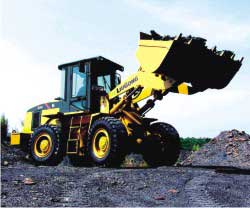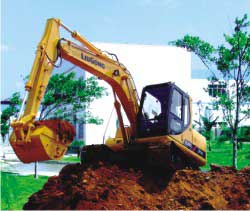Complete Equipment Support at Competitive Price is Our Core Focus

What has been Liugong's performance in India so far in contributing to the company"s top line and bottom line growth in China? What are your expectations from your new manufacturing facilities in terms of adding value to your operations in India?
Our performance in India is getting stronger for years and mainly ever since in 2002 when we sold 20 machines. This has been followed by gradual establishment of dealers and finally setting up of the plant and in turn allowing us to expand our footprint further in the country. We are much hopeful from the new facilities, as beyond doubt it would strengthen our presence in India as we have an ambition to be one of the largest wheel loader manufacturer in India. The new facility is likely to provide a revenue of $175–$300 million till 2012–15 when the plant becomes completely operational in its three phases.
What would be the number of equipment units that would be rolled out from the plant initially and down the line investments that is being planned in accordance with the same?
Initially, 50 wheel loaders would be rolled out from phase-1 of the plant. This would be enhanced in future to 3000 units annually based on its given production capacity. While till the year 2012, 2000 units of all variant of Liugong equipment would be rolled out from its phase-2 & phase-3 facilities followed by a planned capital investment of Rs. 500 crores.
Would the production facilities cater only to the domestic market or would it serve your global equipment supply chain?
The new facility would optimally cater to the requirements of the Indian construction equipment market as the facility is centered in India itself. However, it would also cater to the requirements of Sri Lanka, Pakistan, Nepal, Bangladesh, Middle East and African markets as well. The facility would be a part of Liugong's global equipment supply chain.
What was the reason that you chose Pithampur for your manufacturing facilities. How would the location facilitate your production operation in terms of accessibility to raw materials, power and finally supply of the equipment to the dealers post production?

Pithampur would prove ideal for our plant as geographically it is located centrally in India and logistically well connected to various parts of the country. This would enable us to source components from across the country and also to transport our finished equipment to the end–user points. We also found Pithampur ideal as it has got well– skilled vendor base, to meet the component requirements of construction equipment manufacturer like L&T Case and lot of other automobile manufacturers which are also located at Pithampur. Presence of vendors with strong engineering skills is quite essential for our production with our emphasis on localization. Further, Pithampur has suited our requirements better as the cost of skilled manpower is competitive. More importantly, the place is immune to labor unions as like other places in India, which could prove to be detrimental to production.
How is the new manufacturing facility similar to your production facilities in China or with the Chinese model of manufacturing? Are there any specific production quality standards being adhered to in line with your Chinese manufacturing facility to offer quality products at a lesser price? Kindly explain.
The production facility is much similar to the production plan we have in our production facilities across China spread in six cities. The facilities operates with emphasis on economies of scale to keep cost of production down. However, we have made certain modifications to suit Indian regulation, pertaining to environment protection, safety etc. But broadly the overall production standards is much in line with our Chinese manufacturing facilities barring again certain modifications in the production line to meet the specifications for the wheel loaders, laid by the Indian government.
What is the localisation component that the present manufacturing facilities will subscribe. Mention the areas in terms of components of the same for the equipment to be manufactured.
Initially, we would be looking for 40% localization of major and non major components for the wheel– loaders to be manufactured at Pithampur plant. However, till 2012 when the production facility goes on full stream followed our localization component would be to the tune of seventy percent.
Since localization have to be equally supported by vendor development programme. In line with this, have you chalked out any roadmap for vendor development or vendor efficiency initiatives down the line to make the final products qualitative and cost competitive?

How would be your newly laid production output linked to your dealer and distributor network and finally to the users in line with our business strategy of being "closer to the users"?
We are looking at two ways to optimally link our production output to users with a broad approach to provide the deliverables to the users in time along with providing them quality services. In accordance with this, firstly we would be identifying new potential dealers, in addition to the twelve existing dealers. All would be supported by adequate stocks to provide back up support to the users of the equipment. Secondly, as you might be well aware that there are various issues in the country for getting entry permits for the equipment in certain states, we would be looking to address those issues to enable easy access of the equipment by users. Thirdly, we would also look into potential end markets for equipment usage. We would be putting our people by establishing regional offices and resident offices along with dealers in the potential markets to effectively address the buying and post sales requirements of the users so as to provide them better return on investments on the equipment. The initiatives mentioned, would be put in place in phased manner with the intention for being "closer to the customers."
How does Liugong plan to converge its engineering, R&D training and quality systems post commissioning of your manufacturing operations?
We would like to point out that the machines that we would manufacture in India is much similar to the ones we manufacture in China implying that there won't be much extensive R&D to make machines adaptable for the Indian market. However, we have put up an R&D centre in place at our new plant to address any possible changing usage requirements according to which necessary modifications would be made in the equipment. Secondly, we have a single set of training programme for our employees to get them accustomed on the usage of equipment. Our Indian employees would be equipped with the same programme accordingly with the help of our engineers and supervisors from China, to accustom them broadly with Liugong's core engineering values.
India being a heterogeneous market demand of equipment is assorted. Moreover, demand is increasingly being characterized by providing turnkey solution support to the users from buying to commissioning followed by operation. Post commissioning of your operations how would you be placed accordingly?
Let us highlight that Liugong through new facility in place would provide complete range of equipment to the Indian construction market ranging from wheel Loaders, backhoe Loaders, excavators, motor graders rollers etc so as to meet the multivaried market requirements. We would strongly focus on providing turnkey solutions with a view to provide customer support. As per this, we would look into to undertake annual maintenance contacts, fleet management initiatives, equipment retrofittment etc.
NBMCW September 2009



















